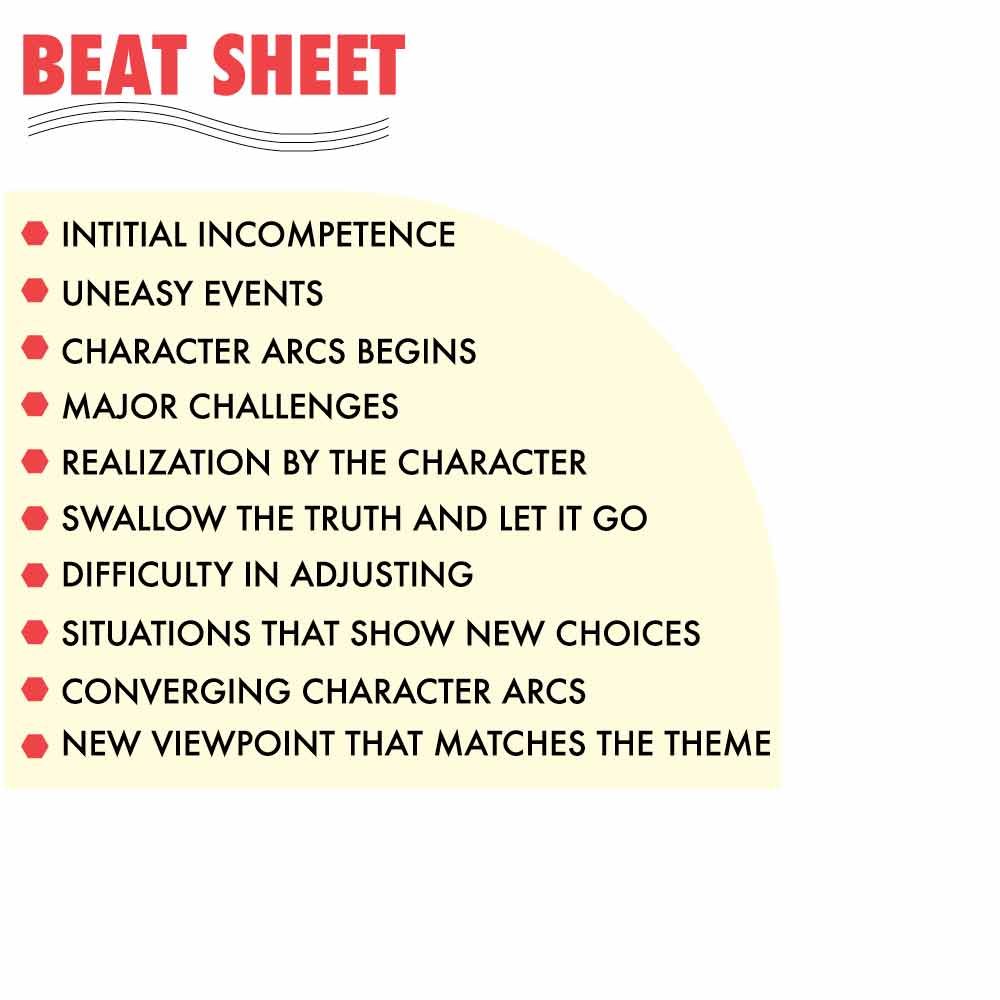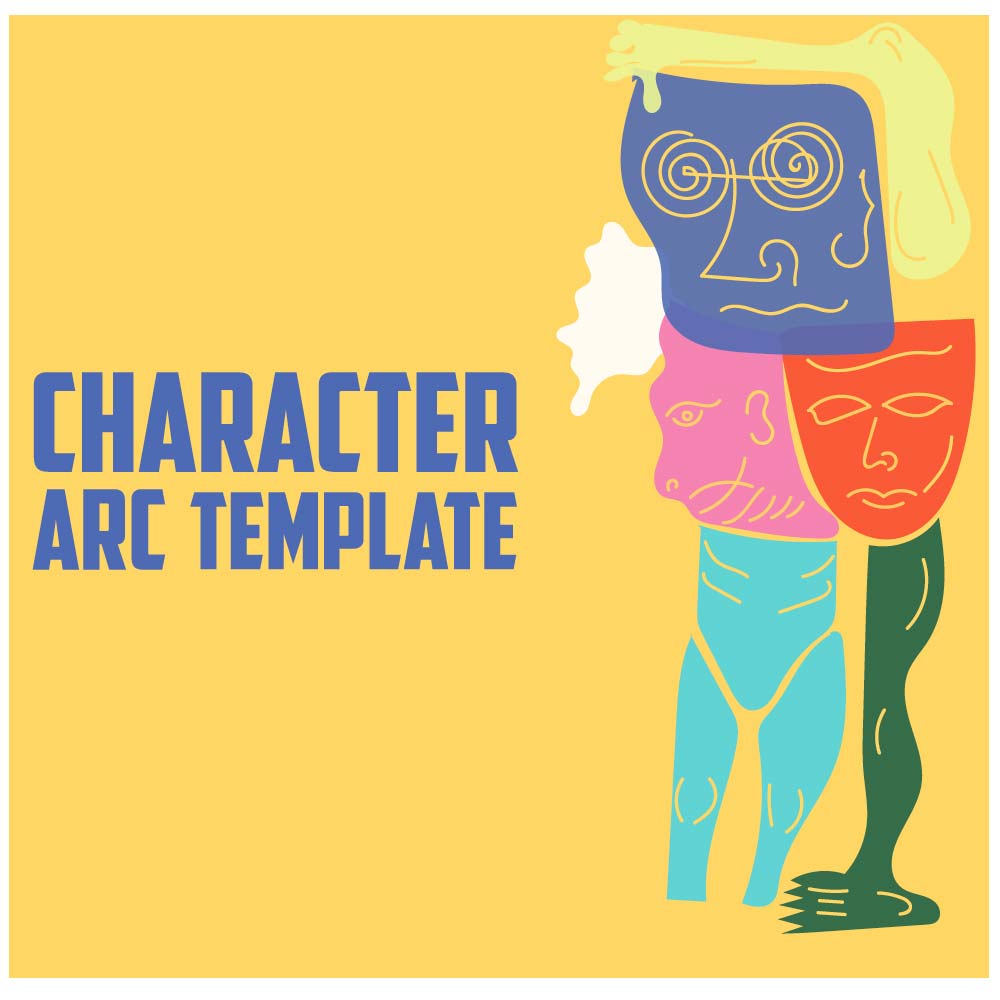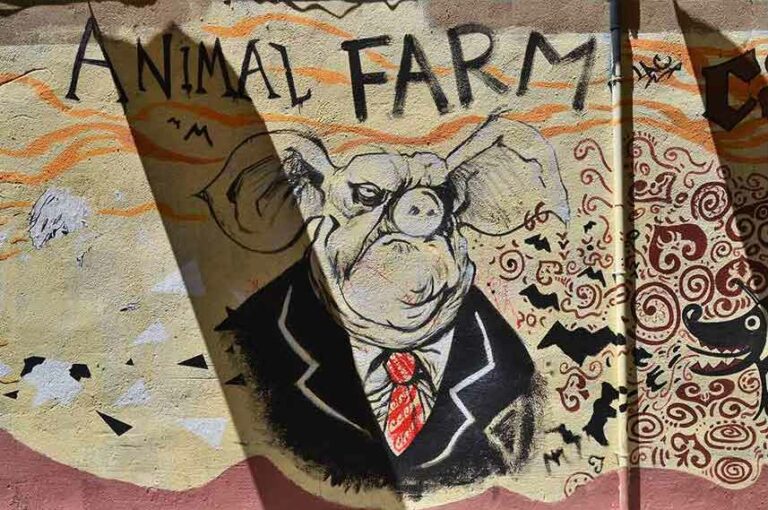Character arcs are just like arcs, similar to the shape of an inverted “U”. What does this mean? You start with a set of traits that the character has, which is not desirable for the story. As the story progresses, the tension increases, and the resistance to the change as well. This is the rise to make the bend of “U”. But in the end, the character reaches a point of stability, similar to what was at the beginning, but in a different position. This is the essence of the character arc template.
Different stories have different themes. And in all these different themed stories, you have different characters. However, the character arc or the internal configuration of a character changes very similarly. This is what connects the readers or the viewers (in the case of movies and shows) with the characters and makes them feel emotions for them.
Basics of character arcs
A character arc is for every important character. The center stage is taken by the protagonist, but the background is never empty. This means that all the side-characters must have their transformation and contribute to the narrative. Even the antagonists must have a character arc, or else they come off as unidimensional and insipid.
The character arc for the side/supporting characters is very necessary because the protagonist is not alone in the “stage”. The protagonist interacts with the situation as well as with the characters, friends, and foe. And whatever he/she does, affects the side characters as well.
To get an apt idea, a character arc for each character is a complex web of interaction with the thought and situation. Then there’s another complex web that spans across all the characters, linking them and making them prone to each other’s actions. This is why character arcs are needed. Let’s have a look at the character arc template with some example and their importance.
Character arc template
Here is an original Wordsverse character arc template to get an idea about how character arcs progress. Remember, just as the story’s pacing must be kept in mind, the character transformation pace must be proportional (major events incite major changes, smaller, gradual ones do it gradually).
Character arc can be divided based on “acts”. Let’s assume there are three acts in your story (in most of the cases there are more but for the sake of simplicity, let’s take three).
Act one is where you establish all the shortcomings in the character, internally. It is not limited just to the protagonist. Every character must have some flaws to keep their characters interesting.
Show all the issues and conflicts that arise because of their mindset and choices in the first act. There should be a steady downhill in the characters’ conditions.
Act two is when a major event happens and it jolts the characters, mainly the protagonist. This is where the story gets into the actual plot of the story. Now things are getting serious and the character has started to realize the issue with his/her thinking.
Act three is where the character touches the lowest point of his/her morale and now completely sees what was wrong with the choices he/she made. Then there’s the struggle and now the new way of thinking results in victory or the achievement of the desired goals.

This was how the character arc progresses based on the acts of the story. But this is much easier written than written in a story (a twist of easier said than done).
In a story, nothing is isolated. Every event and every character motivation is interconnected, affecting the outcome. So keep in mind that never assume that the protagonist won’t be affected by other character’s choices and thinking. More about that later. Let’s have a look at the beat sheet of character arc.
The character arc beat sheet has 10 beats. Here are the beats;
- Initial incompetence
- Uneasy event
- Beginning of character arc
- Major challenges
- Realization by the character
- Swallowing the truth and letting it go
- Difficulty in adjusting to a new mindset
- Challenges that show choices
- A converging character arcs
- A new viewpoint that goes with the theme
Do note that these steps are more like a gradient rather than solid bands of distinct colors. Each step bends into the other one seamlessly. So make sure to follow the seamlessness in your story as well.
Initial incompetence
This is the beginning of the story of your main character/s. Introduce the world, the environment, and the character traits of the protagonist. This is what many call the “lie” which means the characters believe what they think is right, even though the readers can see it isn’t.
This creates a series of issues for the characters, difficulties in understanding the situations, and hence their choices are flawed, almost always choosing the wrong thing.
In the novel “Gone with the Wind”, Scarlett thinks that she knows what’s right for her. Her love for Ashley is unbound and her choices are immature, bizarre, and illogical. She does not see the sense that’s in Rhett. This is the “lie”.
The incompetence here is the characters’ inability to manage the challenges they face. This sometimes also lead to conflicts with other characters. But our protagonist is unable to see it and continues with their methods.
Uneasy event
The uneasy event is the mild, inconvenient event that leads to a small change in the character’s thinking. But it isn’t the major challenge. These are small events that make the character see for themselves what is wrong with their mindset.
These small series of events is necessary because no believable character (or someone in real life) faces one challenge and then changes completely. Doing that makes the character uninteresting and the character arc seems unearned.
Using the novel “Gone with the Wind” again, we see that Scarlett goes through a series of events that push her thinking, making her think about her choices. These events affect her mindset and character, but there isn’t that great of a change. This makes the readers anticipate the change to come and makes your book, a page-turner.
Beginning of character arc
After the series of uneasy events that challenge the mindset of the character, we start seeing the character arc. This can be shown by the character’s choices. Now we start seeing the changes that match the theme of the story.
The beginning of the character arc is the payoff you provide the readers after the series of uneasy events. In the movie “Batman Begins”, the beginning of the character arc for Bruce Wayne is when Rachel slaps him and reminds him of the wrong choice he was about to make. Notice that this is the beginning of the character arc, not the complete arc. Bruce goes through a lot of changes.
Realization by the character
This is what I mentioned in the previous part (as these steps are like a color gradient). Realization by the character is associated with the beginning of the character arc, right after the major event.
As a writer, you must make the readers see that the character has realized something, but never tell it directly. Make the character feel the new change. Keep it subtle, keep it effective and impactful.
Swallowing the truth and letting it go
As the realization continues, the main character (or any character you want the arc to continue) starts to see all the things he/she was wrong about. This is a steady climb and the more the character sees and lets go of his old ways, the more the readers are invested in the story.
This part usually marks the end of act two and the slow decline of the character and the acceptance of the new mindset will take them into new lows. This is needed. Let the characters go through a storm of internal conflict, as in act three, the external conflict comes as well.
Difficulty in adjusting to a new mindset
This is the beginning of act three of the story and when the external conflict affects the characters substantially. Not only the character is going through difficult times, but he/she is also suffering internally as well.
No change in the way you think comes easy without your mind holding on to your previous ideals. This friction that is created makes the readers feel for the characters. The characters going through the arc are in their absolute worst. This is the “bend” point of their “U”-shaped arc.
Challenges that show choice
This is where you can use the external conflict to show the change in the characters. Unpleasant events that are happening in the story create a choice for the character and he/she is forced to make a choice.
Here, after the long struggle with themselves to adjust to something new, they meet something familiar. Remember, the choices they face must also have a choice that the past version of the character must have chosen.
But now, since the character is changed, you establish that with the choice the character makes now. The character makes the right choice (driven by the theme of the story) and this establishes the (almost) completion of the character arc.
A converging character arcs
Not only there should be a character arc for the protagonist, but also the supporting characters, even the antagonist (discussed later). During the whole course of the story, the peripheral characters must also go through a similar arc and in this part, i.e., the near end of act three, all the arcs must converge.
Every character must come up with a new version of themselves, with the conflict between the characters resolving. Everyone comes together and this provides an input to the victory that the protagonist learns.
Final viewpoint congruent with the theme
This is the establishing part of the story which is very similar to the first part. The difference here is that now the character sees the world with a different set of eyes. Things have changed. The theme of the story has now been achieved.
The final viewpoint is not about to show that the character has changed. This change (or arc) was already almost completed in challenges that show choice. This part is to show that the characters are not struggling with the change anymore. They have happily changed and are comfortable with it.
This part shows that the choices (right choices, according to the theme) can be taken by the characters without any accompanying challenges. The right choices can be made by them easily.
This concludes the beat sheet for the character arc template. Most of the stories follow this method of developing a character. However, variations are important to make your story stand out. And sometimes, this whole process is jumbled, or not even used at all.

Learn more about writing:
- Save the cat beat sheet for beginners to understand the structure of the story
- Why imagery is important; By Stephen King
- Learn how to write a great and interesting feature article
When character arcs are different
Not always you’ll have stories having the same character arcs as described above or anywhere else. Sometimes the character arcs are unique to their authors. This does not mean the character arc mentioned here or anywhere is redundant. You must know the basics before creating something of your own.
Here are some of the exceptions where character arcs are executed in different ways;
- In Sherlock Holmes (TV series), Sherlock shows himself to be an uncaring person, not affected by what others think of him and showing low regard for Watson. But as the story unfolds, we learn that he actually cares about Watson and Mary and everyone else he’s associated with. Here, the readers don’t know about the character arc until it is revealed to them.
- In Gone with the Wind, the character arc begins with the ending of the novel. We see Scarlett realizing her mistakes and rushes to Rhett, finally knowing that she loves him. But that is the end of the novel. This makes the ending so great. And if you disagree with me, then frankly dear, I don’t give a damn.
- There is also a negative character arc, where the characters move opposite of the theme of the novel. One such example is Hamlet. Antagonists usually follow this arc and this is rarely shown in stories. It is necessary to show the change in the antagonist as well. Characters need to be connected with the bad guy and why he/she became what they are.
- If the character arc is executed too quickly, the readers are never going to believe it. A recent debacle was the finale of A Game of Thrones. Daenerys Targaryen was the benevolent, justice-loving queen for the entire run of the show and then in the final episode, a tolling bell changed her completely? This was rushed writing and should be avoided at all costs.
The idea that I want to convey is to take the basics from this character arc template and then try adding your flavor to it. Try bending how your story and its external conflict affects the inner conflicts of the character. Approach every character as if they are real people, with real past and real struggles. This creates a more believable and connecting story.

Character arc vs character development
An often confusing component of a story is character arc and character development. These two are often looked at as the same thing, but they aren’t. The right way to group these two would be to say two faces of the same coin.
Character traits are the inner condition of the characters, what they think, their philosophy, their morals, and beliefs. These character traits influence what they do in the physical world and over a course of time, it is called character development.
In other words, the character arc is a series of changes in their thinking, morals, and beliefs. Character development is the change in the choices the character makes, influenced by the inner changes.
A character may think there is no justice in the world due to their past experiences. This is a character trait. This trait then translates to their choices or action. The character avoids helping someone in need and lives for himself/herself. But throughout the story, the character traits change and the character now believes in justice and realizes that justice doesn’t exist without people enforcing it. Two changes occur:
- First, the character’s traits have changed, the inner traits of thinking. Now he/she believes that justice is there and in the beginning, they were wrong. This change is the character arc.
- Second, now faced with a similar situation, the character will choose to help the person in need because the character traits have changed. This change of choices, from not helping to help is the character development. I hope this made the difference clear.
Why character arcs are important
I am going to present two examples that will illustrate the importance of character arcs in your story. Without an inner dynamic state, the characters have no motivation, no struggle, and most importantly, no way of connecting the audience with the story. Here’s the first example.
Animation movies are great. The characters are loved, they invoke emotions in us and make us care about them. Be it anime, Pixar movies, etc. Animated movies have made a square robot, clownfish, and inanimate toys as moving characters. How did they achieve that? All thanks to character arcs. These animals such as in The Lion King show human emotions, flaws, and the tendency to change and this is what makes the story and characters interesting.
The second example is character arcs imitate life. In all these animated movies, you see the characters going through a similar problem that humans go through. This is what connects the audience with the readers and viewers. Because in real life, we change. You or I or anyone is not the same person as we were 5-years ago. Five years is being generous, we change every day. This dynamic state of the characters in stories puts us in a very important illusion.
The illusion of reality. The characters feel real, even if we know they are created by the author. This is what puts us in their shoes and feel the joy and pain and struggle and the fruits of struggle with the characters. And this is what makes a story successful. This is why your character needs an arc.
Without the character arc, there is no emotional investment, no empathetic connection with the characters. They feel animated, stale, and uninteresting.







